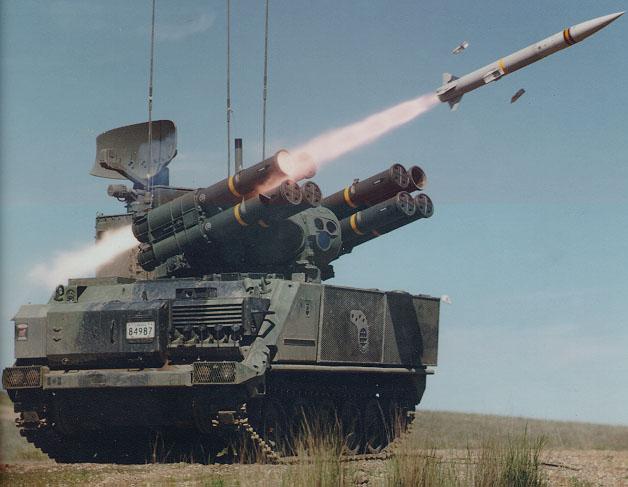Oerlikon/Lockheed Martin MIM-146 ADATS
In the 1970s, the Swiss company Oerlikon-Bührle (now Oerlikon Aerospace) studied a low-cost mobile air-defense missile with a secondary capability as an anti-tank weapon. The system was therefore designated ADATS - Air-Defense Anti-Tank System. In 1979, Martin Marietta (now Lockheed Martin) was selected as a partner for the program, and the first firing of an ADATS missile occurred in June 1981. In 1986 Canada selected ADATS as its new low-altitude air-defense system, and in 1988 the first systems were delivered to the Canadian Armed Forces.
The ADATS is a completely self-contained system in an unmanned turret with FLIR (Forward-Looking Infrared) and TV sensors, laser rangefinder and designator, a search radar, and eight missile launch canisters. This turret is mounted on the vehicle, which is in current applications a modified M113A2 armoured personnel carrier chassis. When the X-band pulse-doppler search radar has detected a target, it is tracked by the passive optical (TV or FLIR) sensors, which are immune to anti-radiation missiles and ECM. When the target is in range, a missile is fired, and guided along a digitally coded laser beam. The missile's dual-purpose (anti-armour/anti-aircraft) warhead is detonated either by a laser proximity or by a mechanical impact fuze. The missile can be used against low-flying aircraft and helicopters, as well as armoured vehicles and tanks. While this dual capability may sound very advantageous at first, the missile is much more expensive than other anti-armour missiles. Therefore it is de facto used by Canada as a pure air-defense weapon.
 |
| Photo: Canadian Armed Forces |
| ADATS (MIM-146A) |
After the U.S. Army's M247 "Sergeant York" DIVAD (Division Air Defence) air-defense gun system was cancelled in 1985 (after a lengthy, expensive and troublesome development), the Army had to look for a replacement to fulfill the FAAD (Forward-Area Air Defense) role. The new system was to replace the old MIM-72 Chaparral and complement the FIM-92 Stinger MANPADS (Man-Portable Air-Defense System). After comparative tests of several systems, the Army decided in 1989 to evaluate the ADATS as the LOS-F-H (Line-of-Sight, Forward, Heavy) air-defense system. The designation MIM-146A was assigned to the tactical ADATS missile, and inert rounds for ground-handling training were designated DMTM-146A.
 |
| Photo: Canadian Armed Forces |
| ADATS (MIM-146A) |
The Army found ADATS unsatisfactory, however, mainly because of low reliability. In 1992 the MIM-146 program was cancelled, and the BSFV (Bradley Stinger Fighting Vehicle) was procured instead. The BSFV uses the FIM-92 Stinger missile, which is currently the missile employed by all U.S. Army forward-area air-defense systems.
The Canadian Armed Forces are the only major customer of ADATS, and more than 900 ADATS missiles have been produced so far.
Specifications
Note: Data given by several sources show slight variations. Figures given below may therefore be inaccurate!
Data for MIM-146A:
| Length | 2.05 m (6 ft 8.7 in) |
| Finspan | 50 cm (19.5 in) |
| Diameter | 15.2 cm (6 in) |
| Weight | 51 kg (112 lb) |
| Speed | Mach 3+ |
| Ceiling | 7000 m (23000 ft) |
| Range | 10 km (6 miles) |
| Propulsion | Hercules low-smoke solid-fueled rocket |
| Warhead | 12 kg (26.5 lb) dual-purpose shaped-charge/fragmentation |
Main Sources
[1] Hajime Ozu: "Missile 2000 - Reference Guide to World Missile Systems", Shinkigensha, 2000
[2] Bernard Blake (ed.): "Jane's Weapon Systems 1987-88", Jane's, 1988
[3] Lockheed Martin Missiles & Fire Control Website
[4] Army Technology Website
Back to Current Designations Of U.S. Unmanned Military Aerospace Vehicles
Back to Directory of U.S. Military Rockets and Missiles
Last Updated: 5 November 2002